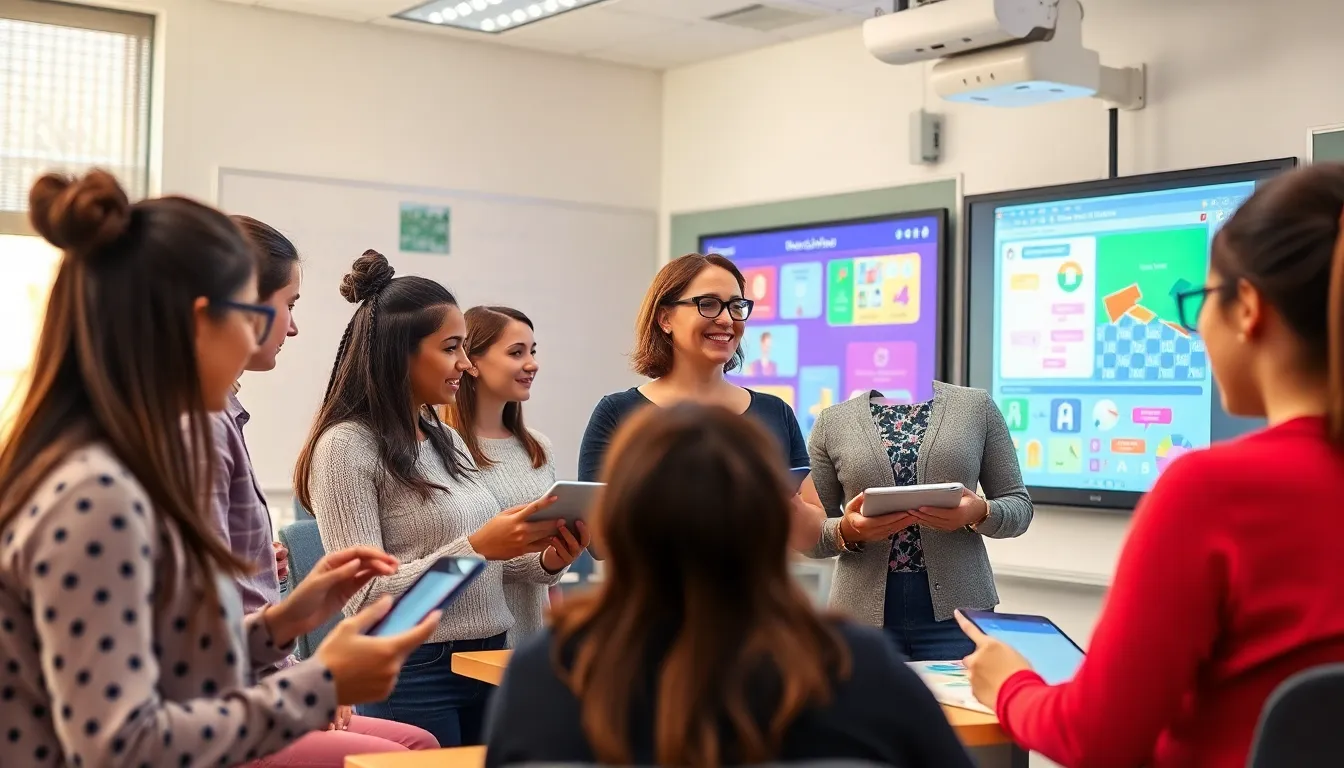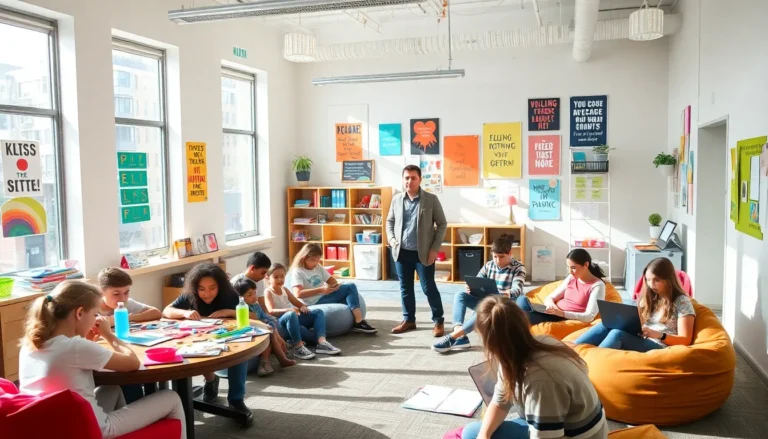In a world where smartphones are practically an extension of our hands, educational technology is the superhero we didn’t know we needed. Gone are the days of dusty chalkboards and endless textbooks. Instead, classrooms are buzzing with interactive tools that make learning as engaging as binge-watching the latest series. Who knew that algorithms could be so entertaining?
Table of Contents
ToggleUnderstanding Educational Technology
Educational technology encompasses tools and resources that enhance learning experiences and improve educational outcomes. The sector includes software applications, digital platforms, and devices designed to facilitate education.
Definition and Scope
Educational technology refers to the integration of digital tools to support teaching and learning processes. It includes online learning platforms, virtual classrooms, and multimedia resources. Schools employ these technologies to promote interactive and personalized learning experiences. Institutions use educational technology for administrative tasks, curriculum development, and assessment. Teachers leverage these resources to engage students and foster collaboration.
Historical Context
Educational technology’s evolution began with the use of simple tools like projectors and overheads. As technology advanced, the introduction of computers and the internet revolutionized educational practices. The late 20th century saw the rise of e-learning and distance education, making learning accessible to diverse populations. Schools began incorporating multimedia resources into classrooms during the 21st century. Today, educational technology continues to evolve with innovations such as artificial intelligence and augmented reality, reshaping how educators deliver content and engage students.
Key Components of Educational Technology

Educational technology comprises various essential elements that enhance teaching and learning. These components include hardware, software, and online platforms, each playing a vital role in creating effective educational experiences.
Hardware
Hardware includes essential physical tools that support learning activities. Devices such as computers, tablets, and interactive whiteboards facilitate engagement and interaction. Projectors and smart boards enhance classroom presentations, making content more accessible. Virtual reality headsets offer immersive experiences, transporting students into different environments for a deeper understanding. Each piece of hardware contributes to a dynamic and enriched learning setting.
Software
Software encompasses applications and programs designed for educational purposes. Learning management systems enable teachers to organize courses and track student performance. Interactive tools, such as simulations and gamification apps, promote active learning. Multimedia resources, including videos and podcasts, provide diverse content formats that cater to various learning styles. Educational software adapts to students’ needs, offering personalized experiences that foster growth.
Online Platforms
Online platforms create spaces for collaborative and remote learning. Virtual classrooms allow students to participate from anywhere, breaking geographical barriers. Educational websites offer resources, lessons, and assessments that support independent learning. Learning management systems streamline communication between educators and students. Many platforms also incorporate social learning aspects, encouraging engagement and interaction within learning communities. Each platform plays a crucial role in modernizing educational experiences.
Benefits of Educational Technology
Educational technology significantly enriches the learning process. Its integration results in interactive tools that engage students like never before.
Enhanced Learning Experiences
Interactive learning tools boost engagement and motivation among students. Virtual classrooms facilitate real-time discussions, enhancing collaboration. Multimedia resources provide varied learning formats, catering to different learning styles. Gamified elements make lessons more enjoyable, turning education into an exciting adventure. With personalized learning paths, educators can tailor content to meet individual needs. These strategies ensure that every student feels involved and connected to the material.
Accessibility and Inclusion
Accessibility stands out as a crucial benefit of educational technology. Students with disabilities gain access to resources that support their learning without barriers. Adaptive learning technologies provide customized experiences that accommodate different needs. Online platforms enable anyone to learn from anywhere, breaking geographical barriers. Inclusive resources foster participation from diverse student backgrounds, ensuring equal opportunities. This commitment to accessibility helps create a more equitable educational environment for all learners.
Challenges in Educational Technology
Educational technology faces several challenges that impact its effectiveness in learning environments. These obstacles often hinder the full realization of its potential benefits.
Digital Divide
The digital divide refers to the gap between those who have easy access to technology and those who do not. Access to devices and reliable internet affects students’ ability to engage with educational resources. Rural students experience more significant barriers due to limited infrastructure. Low-income households often struggle to afford necessary technology, leading to unequal learning opportunities. Schools can address this divide by investing in resources for underprivileged areas. Connecting communities through Wi-Fi initiatives represents one effective solution.
Resistance to Change
Resistance to change acts as a barrier in many educational institutions. Educators who are accustomed to traditional teaching methods often hesitate to adapt to new technologies. Professional development opportunities can support teachers in overcoming their fears and insecurities. Some administrators may prioritize existing curricula over innovative approaches, slowing implementation. Encouraging a growth mindset among staff fosters openness to change. Providing ongoing support and showcasing the success of technology adoption can further ease this transition.
Future Trends in Educational Technology
Emerging trends in educational technology continue to revolutionize the learning landscape. Significant advancements in artificial intelligence and virtual reality reshape how students interact with educational content.
Artificial Intelligence in Education
Artificial intelligence transforms educational experiences through personalized learning. AI-driven platforms analyze student data to customize lessons based on individual strengths and weaknesses. Adaptive learning systems offer real-time feedback, helping educators identify areas that require additional support. Intelligent tutoring systems provide additional help outside the classroom, ensuring students stay engaged with complex subjects. Furthermore, chatbots offer instant assistance to learners, facilitating immediate interactions and enhancing motivation. Institutions implementing AI see improved educational outcomes, making these technologies vital for future classrooms.
Virtual and Augmented Reality
Virtual and augmented reality introduce immersive learning environments that captivate students. These technologies allow learners to explore complex concepts through hands-on experiences. By simulating real-world scenarios, students can practice skills in risk-free virtual settings. For instance, medical students benefit from virtual surgeries while engineering students can experiment with designs in 3D space. Augmented reality adds a digital layer to physical books, enhancing traditional learning materials with interactive elements. Current trends highlight a growing emphasis on incorporating these elements in curricula, which fosters deeper understanding and increased retention of information.
Educational technology is reshaping the landscape of learning. Its ability to engage students through interactive tools and personalized experiences is revolutionizing traditional education. As schools embrace these innovations they not only enhance educational outcomes but also foster inclusivity and accessibility.
While challenges like the digital divide and resistance to change persist addressing these issues is crucial for maximizing the benefits of educational technology. Continued investment in resources and professional development will empower educators to effectively integrate new tools into their teaching.
The future of education lies in the ongoing evolution of technology. As advancements like AI and VR become more prevalent they promise to create even more immersive and engaging learning environments. Embracing these changes will ensure that students are well-prepared for the demands of a rapidly changing world.




